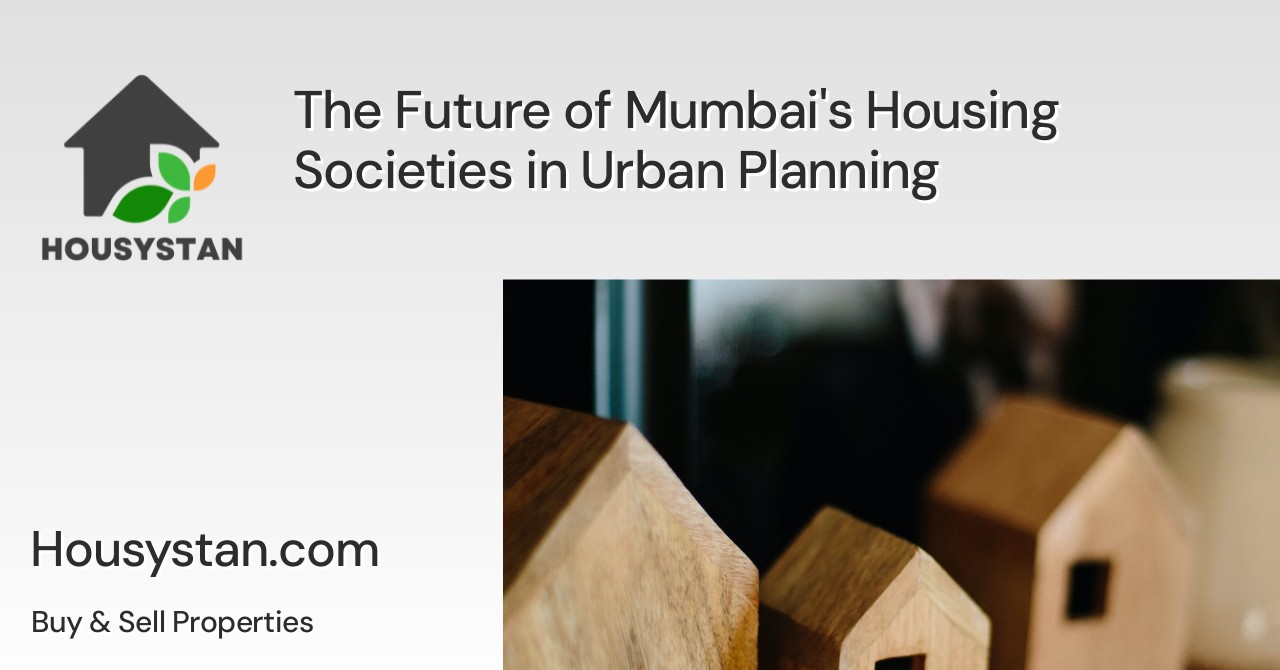The Future of Mumbai's Housing Societies in Urban Planning
Read latest blogs and articles from Housystan

The Information mentioned here was last updated on:
11/12/2025The Future of Mumbai's Housing Societies in Urban Planning
Mumbai, the city of dreams, is continually evolving, with its skyline being punctuated by new developments. As a city with finite space and a burgeoning population, Mumbai faces unique challenges when it comes to urban planning. A crucial element in this narrative is the housing societies that play an integral role in the city's residential life. As we look to the future, these societies must adapt to emerging needs and challenges.
Understanding Housing Societies in Mumbai
- Verified Tenants/Buyers
- Unlimited Property Listing
- Zero subscription/charges fee
Housing societies in Mumbai are essentially communities of residents living in multi-story apartment complexes. Formed under cooperative laws, these societies manage the functioning and maintenance of the buildings in which their members reside. Operating democratically, they handle everything from essential services like water supply and waste disposal to community issues and events. The cooperative housing model is a popular choice due to its efficiency and community-driven focus.
The Rise in Demand
Mumbai's population keeps growing, with people from all over India flocking to the city in search of opportunities. This continuous influx intensifies demand for housing, which presents both an opportunity and a challenge for housing societies.
Space Constraints
The city is geographically narrow, hemmed in by the Arabian Sea on one side and natural parkland on another. This squeezed geography limits the availability of land for new construction, making vertical growth a necessity. Housing societies play a pivotal role in maximizing land usage, with many old structures giving way to taller complexes that can accommodate more residents.
Issues of Affordability
A noteworthy challenge is affordability. Property prices in Mumbai are among the highest in India, making it difficult for middle-income families to own homes. Housing societies often try to mitigate this by pooling collective resources and mediating between residents and developers. However, the struggle against rising costs is ongoing and requires innovative financial solutions.
Modernizing Infrastructure
As housing societies adapt, upgrading infrastructure becomes imperative. With advancements in technology and changing lifestyle preferences, societies need to offer more than just basic amenities.
The Green Revolution
Sustainability is a pivotal part of urban planning today. Housing societies can no longer ignore the impact they have on the environment. Incorporating green building practices, like solar panels and rainwater harvesting systems, can help reduce carbon footprints and lower utility expenses. Moreover, green spaces within housing complexes provide residents with recreational areas and promote a healthier lifestyle.
Technological Integration
The rise of smart technology significantly impacts how housing societies operate. Automated systems for energy management, security, and waste management can enhance efficiency and safety. Implementing high-speed internet and smart communication systems among residents improves connectivity and engagement, ensuring that housing societies are on the cutting edge of urban living.
Community and Lifestyle Changes
Housing societies aren't just about buildings; they're about fostering community living. With evolving lifestyles and demographics, these communities are adapting to meet new social needs.
Promoting Inclusiveness
Mumbai’s diverse population means housing societies are highly heterogeneous. Planning for inclusivity involves ensuring that societies are accessible and welcoming to people of all ages and abilities. Facilities like ramps, elevators, and elderly-friendly amenities are becoming more common, reflecting a shift towards more inclusive living environments.
Encouraging Social Interaction
Modern housing societies emphasize the importance of community interactions. Shared spaces such as clubhouses, playgrounds, and event halls are integral features that foster communal bonds. These areas serve as venues for festivals, meetings, and recreational activities, helping to build a sense of community and belonging.
Navigating Regulatory Changes
Urban planning in Mumbai is subject to stringent regulations, and housing societies need to navigate these legal frameworks effectively.
New Development Rules
The Maharashtra government frequently updates its development control regulations to manage the city's growth. Housing societies need to stay informed of these changes, especially when considering redevelopment or constructing new facilities. Understanding the implications of such rules on factors like floor space index (FSI) and building height restrictions is essential for compliance and maximizing property potential.
Rehabilitation and Redevelopment
Old and dilapidated structures are a common sight in Mumbai. Redevelopment is a practical solution, where housing societies partner with developers to create modern buildings that meet current safety and convenience standards. This approach not only rebuilds infrastructure but also enhances the living experience, providing upgraded facilities and more robust structures to withstand natural calamities like flooding and earthquakes.
Collaborating for a Better Future
Effective urban planning requires the collaboration of various stakeholders, including the government, developers, and residents of housing societies.
Public-Private Partnerships
These partnerships can lead to innovative urban solutions. Housing societies working alongside local authorities and private companies can access resources and expertise that may otherwise be out of reach. This collaboration can address infrastructure challenges, such as improving public transport connectivity and enhancing public utilities, ensuring they align with society needs.
Engaging the Community
Residents’ involvement is critical for the success of any development initiative. Active participation in decision-making processes empowers members, ensuring that changes align with their needs and aspirations. Transparent communication between society management and residents also builds trust and community spirit.
Mumbai’s housing societies are central to the city's urban fabric. As they adapt to the complexities of modern urban life, they shape not just the skyline but the community experience itself. The challenges are numerous, from regulatory hurdles to environmental considerations, but they also present opportunities for creating vibrant, sustainable communities. As Mumbai continues its journey toward an urban future, these societies will be at the forefront, charting a path that balances growth with quality of life for all residents.